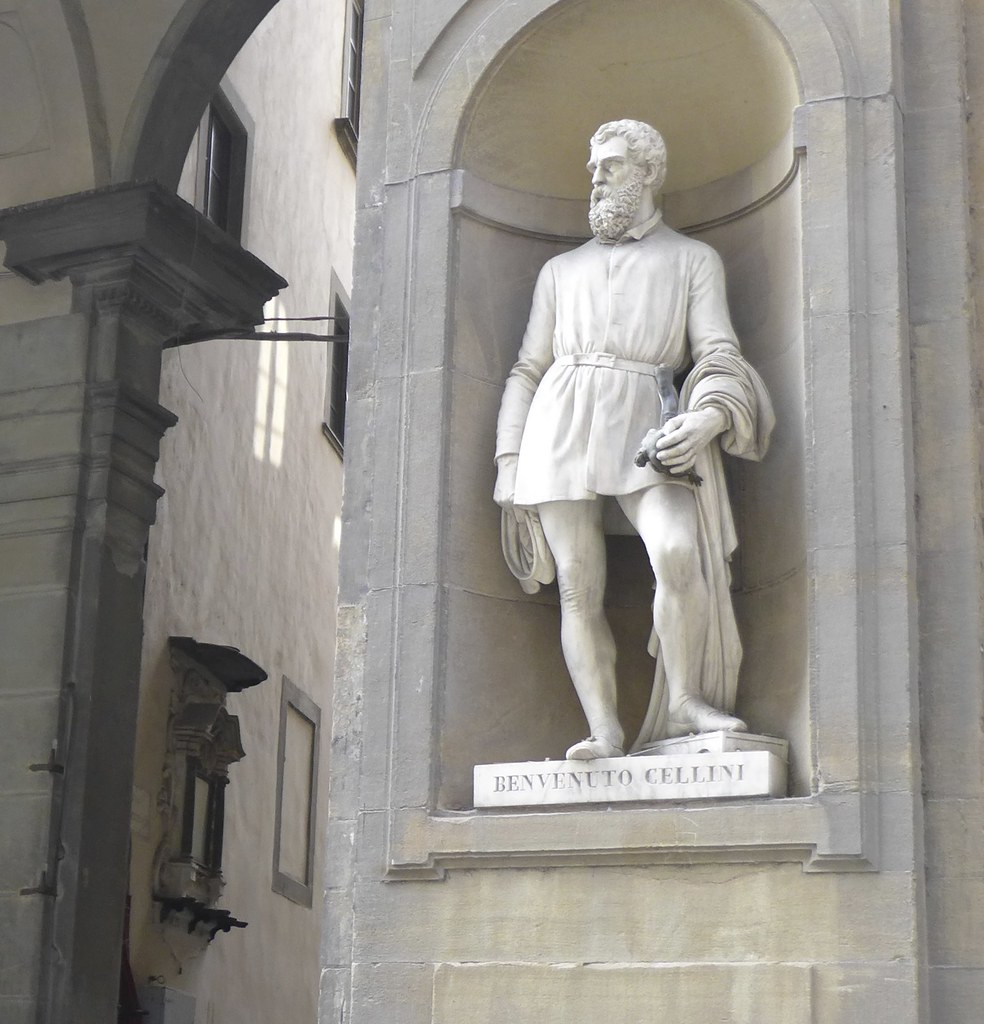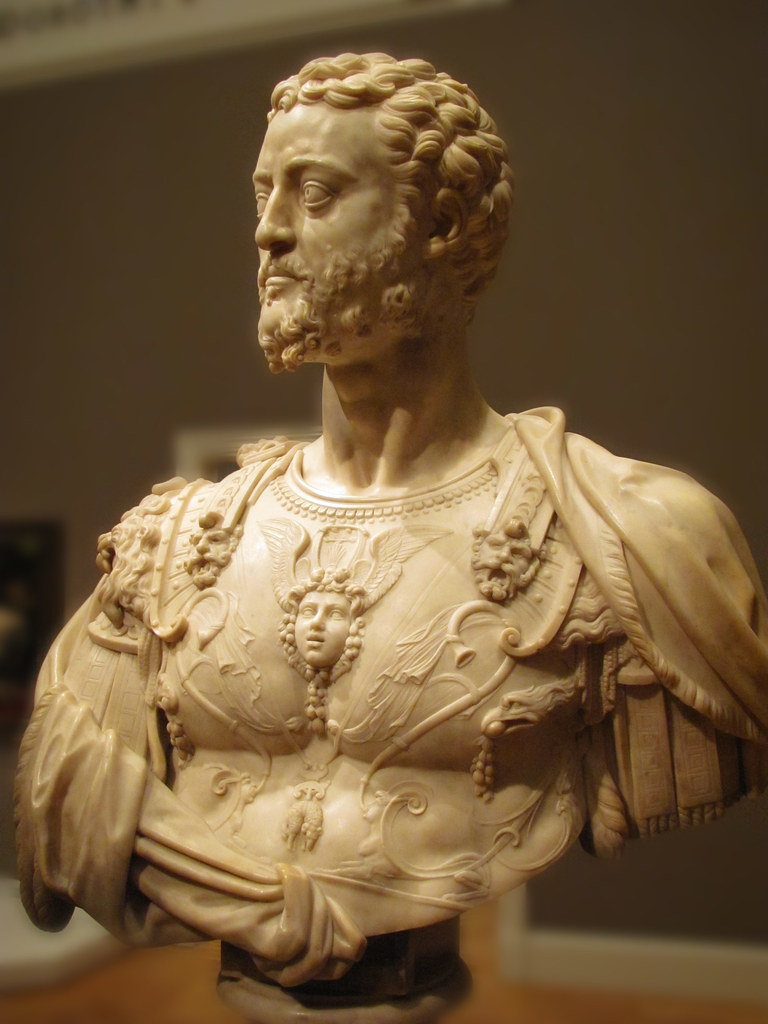Goldsmith, sculptor, draftsman, soldier and musician, Benvenuto Cellini is considered one of the main figures of Italian Renaissance. He was also the author of the celebrated Romantic book: “Autobiography of Benvenuto Cellini”.

Image source: https://search.creativecommons.org/photos/cb5166ea-a98e-4d2e-bec8-cc38079c9ad7 by pnh
This celebrated Italian artist and craftsman was born in November, 1500, in Florence, Italy. Cellini lived a colorful life and his account of the working life of a sixteenth century artist in his Autobiography recounting relations with his family, friends, enemies, and patrons was celebrated in countless translations by Johann Wolfgang von Goethe and served as the basis for an opera by Hector Berlioz, Benvenuto Cellini 1837.
Given the immense pride that Benvenuto Cellini took in his talents, it is ironic that very few certain examples of his art as a sculptor exist today and that he is best known for his Autobiography. It is an extraordinary record of absorbing interest on many levels: a spirited and candid revelation of a complex character; a narrative of historical importance for its account of the working life of a 16th-century artist in his relations with his family, friends, enemies, and patrons; and a document of great interest for a description of the techniques of sculpture which has still not been fully investigated.
Info source: http://biography.yourdictionary.com/benvenuto-cellini
Early Life
Benvenuto Cellini was the third child of the musician Giovanni Cellini. At the age of fifteen, contrary to the hopes of his father, he was apprenticed to the Florentine goldsmith Antonio di Sandro. The following year he fled to Siena to escape charges of riotous behaviour, where he continued his training under the goldsmith Fracastoro. From Siena he moved to Bologna, visited Pisa and returned twice to Florence, before leaving for Rome. He was nineteen years old but already attracting attention for his metalworking ability.
Image source: https://search.creativecommons.org/photos/642f57ab-43b1-465a-a184-a545eec320ba by Cstutz
Info source: http://www.visual-arts-cork.com/sculpture/benvenuto-cellini.htm
Roman Period
Benvenuto fled to Rome and soon began to receive important commissions from the Bishop of Salamanca, Sigismondo Chigi, from his wife, Porzia, and from Pope Clement VII. At this time, he was artistically mature; he began to work for himself and not for other goldsmiths and established a shop of his own in Rome.

Image source: https://search.creativecommons.org/photos/0ba9e687-8839-47f0-bd6a-3c94d2088849 by rocor
Image source: https://en.wikipedia.org/wiki/Benvenuto_Cellini#/media/File:Benvenuto_cellini,_papa_clemente_VII,_1534.JPG
In Rome, Cellini’s fine work in drawing, jewelry, and larger pieces such as serving plates and candelabras very soon caught the notice of rich and influential patrons. He was a musician, briefly, in Clement’s orchestra; he did many drawings in the style of Michelangelo and Raphael; he made jewelry and set and estimated the value of jewels; he made cast and carved plate and ornamental silver; and he designed and struck medals and coinage. He was also drawn to military life during this period and participated in the defense of Rome in 1527, during the invasion of Italy by the Holy Roman Empire. At this time, his sculptor’s knowledge of structure and spatiality, translated into engineering, was useful in ordering the pope’s artillery. Later he would design fortifications in Florence. (It was common for sculptors in this period to be called on to use their engineering skills to design weapons, fortifications, and buildings for their cities of residence.)
Info source: https://www.enotes.com/topics/benvenuto-cellini
Working for the French King
A fall-out with the Pope in the late 1530s ultimately led to Cellini’s move to France where he worked at the court of Francis I. Cellini spent the years 1540-1545, serving the king as sculptor, decorator, and designer of architectural projects for the royal château of Fontainebleau. At the royal residence in Fontainebleau, where François I imported numerous Italian artists in an effort to promote an artistic Renaissance in France, Cellini’s sculptural projects reached their most ambitious heights. In 1543 he completed the famous and elaborate Salt Cellar from a model prepared earlier for Cardinal Ippolito d’Este. Cellini made models for a series of 12 silver statues of gods and goddesses and executed two bronze busts and silver vases (all now lost). He cast the bronze lunette of the Nymph of Fontainebleau (1545).

Image surce: https://search.creativecommons.org/photos/3ffb4b9d-e65a-4137-9480-7ad24b49a0f9 by smerikal
As always, however, his temperament, artistic skill and debauchery ensured him of numerous enemies, whom he was unable to subdue by physical means. As a result, after five years of successful goldsmithery, he left Fontainebleau and retired to Florence.
Info source: http://www.visual-arts-cork.com/sculpture/benvenuto-cellini.htm
Latest Works in Florence
Cellini returned to Florence, where he continued as a goldsmith, but also took up large-scale sculpture. For Duke Cosimo de’ Medici he executed a bronze portrait of the duke, some marble statues of classical themes, and his most ambitious creation, the bronze Perseus in the Loggia dei Lanzi. Cellini’s love of classical allusions, elaborate decorative effects, and formal elegance makes the Perseus appear more constrained and more stylish than the artist’s tempestuous account of its casting would suggest. During the war with Siena, Cellini was appointed to strengthen the defences of his native city, and, though rather shabbily treated by his ducal patrons, he continued to gain the admiration of his fellow citizens by the magnificent works which he produced. He was also named a member (Accademico) of the prestigious Accademia delle Arti del Disegno of Florence, founded by the Duke Cosimo I de’ Medici, on 13 January 1563, under the influence of the architect Giorgio Vasari. He died in Florence on 13 May 1571.

Image source: https://search.creativecommons.org/photos/ce2e41ba-e847-4120-87b9-a5b9aa2f34b3

Image source: https://search.creativecommons.org/photos/ca04d17e-1fab-411a-b867-05c4a0ce9e7e by mharrsch
Info source: https://en.wikipedia.org/wiki/Benvenuto_Cellini
The Romantic Hero
Cellini’s lasting fame is due more to his record of his own life than it is to his work as an artist. First printed in Italy in 1728, Cellini’s autobiography was translated into English (1771), German (1796), and French (1822) and, launched on the tide of the Romantic movement, gained immediate popularity.
Cellini myth has become significant in response to his legend as a symbol of the concept of the artist as romantic hero, the actual facts of Cellini’s life remain at least as interesting as the stories. Cellini lived during a period of religious, political, social, and military strife and tension. This stormy atmosphere is nowhere more vividly described than in Cellini’s Autobiography and nowhere more apparent than in the evidence of his own life with its sharp contrasts of egoism and religious faith, worldly ambition and filial devotion, and spirited pride in his own talents and genuine humility in his admiration for the greater genius he saw in the work of Michelangelo and the ancients.

Info source: http://biography.yourdictionary.com/benvenuto-cellini
